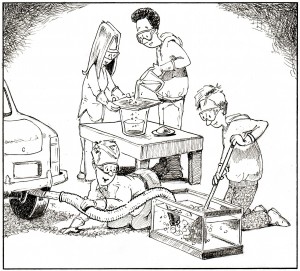Concrete Without Quarries

Originally appears in the Winter 2012-2013 issue
School chemistry labs generally involve mixtures of hazardous chemicals, processed by fossil-fuelled Bunsen burners to facilitate reactions, the products of which are vented into the air, dumped in the garbage, or poured down the drain at the end of each class. The way we teach kids chemistry, in other words, is a microcosm of how we unsustainably manufacture nearly everything in the real world. For a sustainable future, we need chemistry classes to illustrate to kids not how we do it wrong, or even how to do it less badly, but where to look to do it right.
Fully developed practices of sustainable chemistry can be found nearly everywhere you look: out the window, in the cracks of pavement, in the schoolyard and backyard, or at the edge of town. Nature is an expert at manufacturing a wide range of high-performance materials (cement, glass, ceramics, wood), creating clean energy (solar, hydrogen), functional chemicals (colorants, adhesives, etc.) and much, much more. At the same time, nature’s chemical processes generally use commonplace, non-hazardous compounds, which are reactive at ambient temperatures, and transform into fully useful resources again at the end of their service.
Because the natural world has developed a wide range of chemical abilities of interest to human technology, industrial and chemical research is increasingly drawing inspiration from nature in order to improve or reimagine conventional chemical processes. However, little of this work has been translated for use in youth education, in order to transmit these ideas to the next generation of innovators.
This content is restricted to subscribers only.
If you are not yet a subscriber, please consider taking out a subscription here.
If you are an existing subscriber, kindly log in or contact us at info@greenteacher.com for more information.










